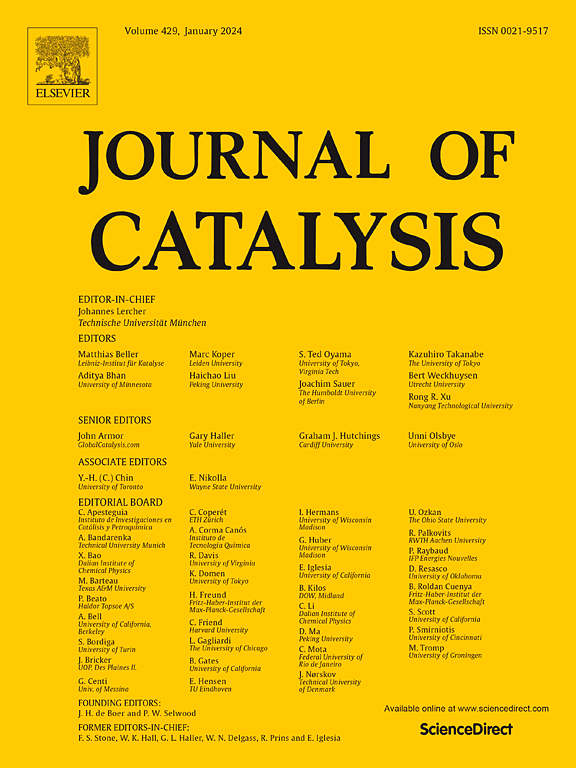Boosting photothermal catalytic non-oxidative methane coupling by high-density frustrated Lewis pairs in Ag/InOxHy
IF 6.5
1区 化学
Q2 CHEMISTRY, PHYSICAL
引用次数: 0
Abstract
The photocatalytic nonoxidative coupling of methane (CH4) is crucial for sustainable energy production and chemical synthesis, however, a key challenge in advancing this process lies in the development of efficient and highly selective catalytic systems. In this study, we employ an in situ thermally induced strategy to promote the in-situ growth of oxygen vacancies (VO) for constructing a high-density In-VO-In-OH frustrated Lewis pairs (FLP) on Ag/In(OH)3-InOOH (Ag/InOxHy). Our results demonstrate that FLP can effectively polarize C–H bonds, while Ag nanoparticles serve as electron acceptors, significantly reducing the recombination of photogenerated carriers and enhancing the catalytic performance of methane coupling. Benefiting from the high density of FLP and photothermal synergistic effect, we achieve a remarkable C2H6 yield of 339.2 μmol gcat−1h−1 over Ag/InOxHy in a flow methane atmosphere. Notably, in-situ electron paramagnetic resonance analysis not only validates this innovative strategy but also reveals a new mechanism of oxygen vacancy recycling which showcases its great potential to advance other photocatalytic processes.


Ag/InOxHy中高密度受挫Lewis对促进光热催化非氧化甲烷偶联
甲烷(CH4)的光催化非氧化偶联对于可持续能源生产和化学合成至关重要,然而,推进这一过程的关键挑战在于开发高效、高选择性的催化系统。在本研究中,我们采用了一种原位热诱导策略来促进氧空位(VO)的原位生长,从而在 Ag/In(OH)3-InOOH (Ag/InOxHy) 上构建高密度的 In-VO-In-OH 受挫路易斯对(FLP)。我们的研究结果表明,FLP 可有效极化 C-H 键,而 Ag 纳米粒子则可作为电子受体,从而显著减少光生载流子的重组,提高甲烷偶联的催化性能。得益于高密度的 FLP 和光热协同效应,我们在流动甲烷气氛中通过 Ag/InOxHy 实现了 339.2 μmol gcat-1h-1 的显著 C2H6 产率。值得注意的是,原位电子顺磁共振分析不仅验证了这一创新策略,还揭示了氧空位再循环的新机制,展示了其推动其他光催化过程的巨大潜力。
本文章由计算机程序翻译,如有差异,请以英文原文为准。
求助全文
约1分钟内获得全文
求助全文
来源期刊

Journal of Catalysis
工程技术-工程:化工
CiteScore
12.30
自引率
5.50%
发文量
447
审稿时长
31 days
期刊介绍:
The Journal of Catalysis publishes scholarly articles on both heterogeneous and homogeneous catalysis, covering a wide range of chemical transformations. These include various types of catalysis, such as those mediated by photons, plasmons, and electrons. The focus of the studies is to understand the relationship between catalytic function and the underlying chemical properties of surfaces and metal complexes.
The articles in the journal offer innovative concepts and explore the synthesis and kinetics of inorganic solids and homogeneous complexes. Furthermore, they discuss spectroscopic techniques for characterizing catalysts, investigate the interaction of probes and reacting species with catalysts, and employ theoretical methods.
The research presented in the journal should have direct relevance to the field of catalytic processes, addressing either fundamental aspects or applications of catalysis.
 求助内容:
求助内容: 应助结果提醒方式:
应助结果提醒方式:


